
Conference Location
 Loughborough is a town in Leicestershire, central England with a population of 57,600 as of 2004, about one hour and 20 mins away from London by train. It is the largest town in the county (since Leicester is a city)and only a short distance away from Leicester, Nottingham and Derby city centres. It is the administrative centre for the Charnwood district and home to Loughborough University.
Loughborough is a town in Leicestershire, central England with a population of 57,600 as of 2004, about one hour and 20 mins away from London by train. It is the largest town in the county (since Leicester is a city)and only a short distance away from Leicester, Nottingham and Derby city centres. It is the administrative centre for the Charnwood district and home to Loughborough University.
HistoryLoughborough began as a Saxon village. At the time of the Domesday Book (1086) Loughborough probably had a population of about 180-200. By the standards of the time it was a fairly large village. In the 13th century Loughborough became a busy little town. From the early 13th century Loughborough had weekly markets and annual fairs. (In the Middle Ages fairs were like markets but were held only once a year. They attracted buyers and sellers from a wide area). The first mention of a market in Loughborough is 1221, however it may have existed prior to this date. |
|
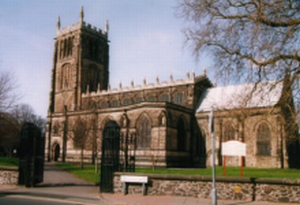
|
In Loughborough traders or craftsmen of one type tended to live in the same street. Bakers lived in Baxtergate. Baxter is an old word for baker and gate is derived from an old Scandinavian word for street 'gata'. So it was baker street. Many of the people of Loughborough kept livestock. Any animals found wandering were put in a pound called the pinfold until the owner paid a fine to get it back. Pinfold gata was the street leading to the pinfold. Also at that time Loughborough Grammar School was founded by a wool merchant named Thomas Burton. |
|
By the late 16th century the town had a population of about 2,000. But, like all towns in those days, however, Loughborough suffered from outbreaks of plague. It struck the town in 1558, 1602-1603, 1609 and 1631. Loughborough also suffered a severe fire in 1622, which destroyed many buildings. However the town was soon rebuilt and through the centuries Loughborough continued to be a busy little market town. In the early 17th century a writer described Loughborough as: "great and large, well situated by reason of the wood and water, adorned with many fair buildings and a large church". From the late 17th century there were framework knitters in Loughborough. They worked in their own homes making woollen stockings, an the industry which became mechanised in the 19th century. |
|
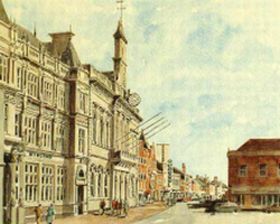
|
In 1841 Loughborough was the destination for the first ever package tour organised by Thomas Cook, for a local temperance group from Leicester. The town has the world's largest bell foundry — John Taylor Bellfounders, who made the bells for the Carillon war memorial, a landmark in the town. On the edge of Loughborough to the north, Dishley Grange Farm was the home of agricultural revolutionist Robert Bakewell. The farm was once home to the annual Leicestershire County Show. |
|
The River Soar passes to the East of the town. Navigation from Loughborough northwards towards the Trent was achieved in 1778 by the construction of the Loughborough Navigation which terminates at Loughborough Wharf between Derby Road and Bridge Street. Subsequently the Leicester navigation was constructed connecting to the Loughborough Navigation at 'Canal Bridge'. The Leicester navigation connects to the River Soar to the South of the town. Both now form part of the Grand Union Canal system. |
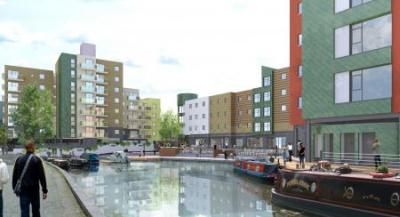
|
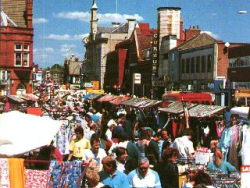
|
The centre of Loughborough's shopping area is the pedestrianised Market Place and Market Street, which maintain a number of original art deco buildings. A large outdoor market is held there every Thursday and Saturday, while a smaller flea market is held on Fridays and there is a monthly farmers' market. "The Rushes" shopping centre has recently been built on the site of the former bus station and is occupied by national chains. The Rushes is linked to the existing town centre area by the streets Churchgate & Churchgate Mews; the latter includes many individually styled independent outlets. |
Below some other nice views of the town.
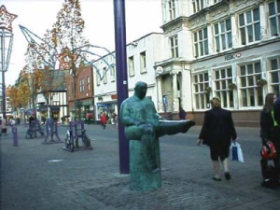
The Famous "Sock Man" |
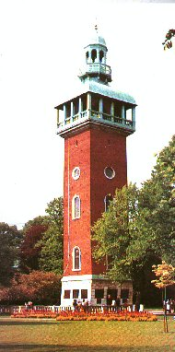
The Carillon |
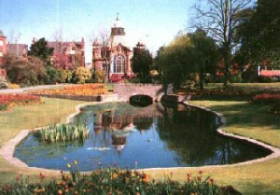
Loughborough Park |
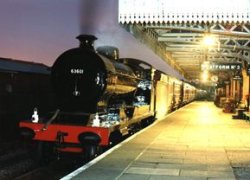
|
For the train enthusiasts amongst you, Loughborough Central Station just south of the town centre is where the Great Central Steam Railway heritage railway is preserved. It operates services every weekend throughout the year. The railway is renowned for being the only double track mainline steam railway in the United Kingdom. |
|
|
|
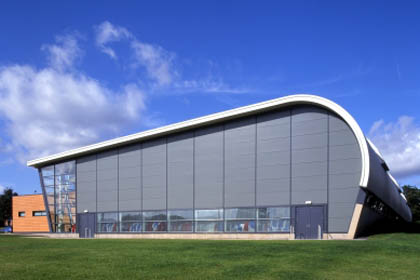
|
Loughborough University is the country's premier university for sports development, research and education. The University has the largest sports scholarship programme in the UK. Currently over 250 international athletes are studying and training there.
|
Parts of this text were copied from 
Conference Venue
The conference itself will be held at the
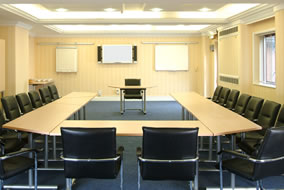
|
Quality Hotel Loughborough |
Getting to Loughborough and the Quality Hotel
By Plane |
When arriving by plane in the UK you are mostly destined to arrive in London either at Heathrow, Stansted, Gatwick or Luton Airport. From these airports you need to make your way by train or tube to St.Pancras Station from where you can take a direct train to Loughborough. or a semi-direct by the way of Leicester. However, if you come by plane the closest airports are either Birmingham Airport or East Midlands Airport, which is really the closest to Loughborough and only about 4-5 miles away from the town. There are several ways you can get from the airport to Loughborough as are shown here. |
By Train |
When taking the train to the United Kingdom, then you will be using the EUROSTAR service arriving at St.Pancras station. After clearing customs and passport control you leave the EUROSTAR part of the station, turn right and up the escalators for all northbound trains to Leeds, Sheffield and Nottingham on East Midland Trains. You can either go direct to Loughborough Station or change trains in Leicester. If you come from Birmingham then take a train from the airport to Birmingham New Street Station and come to Loughborough via Leicester. This will take you 1 hour 30 mins. (See Journeyplanner to work out your itinerary) Loughborough station is located on the eastern edge of the town. |
By Bus |
You can take a National Express Bus from London to Loughborough or once arrived at Loughborough station you can take the Sprint bus service (Campus Bus No. 7), which runs from the Train Station through the Town centre to the campus. Bus times are approximately every 10 minutes. At the final stop exit the bus and the University grounds at the West Entrance and walk about 5 mins to the hotel. |
By Taxi
|
At the station you can also find taxis or you can call this Loughborough based taxi company if none are available. |
By Car
|
The M1's Junction 23 is about 2 miles (5km) west of the town. The north of the town can also be accessed from Junction 24, travelling through Kegworth and Hathern on the A6 road. From Nottingham, drive south on the M1 to junction 24. From Leicester, drive north on the M1 to junction 23A. Signposts along the M1 will help you find your way. See the town map here. |
Hotel Map
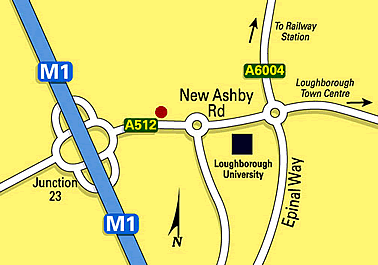

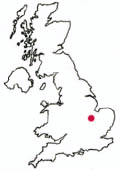
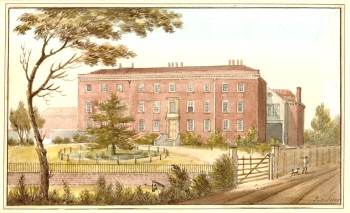

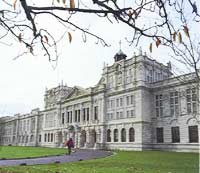
 Tel: +44.(0)1509. 211800
Tel: +44.(0)1509. 211800 Fax: +44.(0)1509.211868
Fax: +44.(0)1509.211868 Email:
Email:














